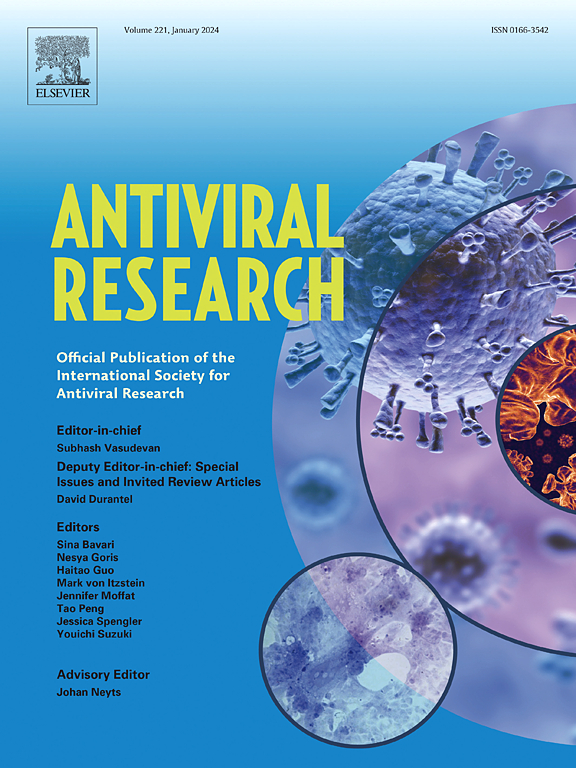Therapeutic determinants of melatonin in hepatitis caused by coxsackievirus B3 infection
IF 4
2区 医学
Q1 PHARMACOLOGY & PHARMACY
引用次数: 0
Abstract
Coxsackievirus B (CVB) is the most recognized enteroviruses associated with acute hepatitis in neonates. It may develop into life-threatening fulminant hepatitis and disseminated intravascular coagulation. Melatonin is a potential agent against infection by modulating inflammation, apoptosis, and oxidative stress. The effect of melatonin on CVB3 replications, cytokine and chemokine productions, and liver damage in CVB3-infected Huh-7 and HepG2 cells were determined. A CVB3-infected hepatitis mouse model was used to explore antiviral, anti-inflammatory, anti-apoptotic, and immunomodulatory responses of melatonin treatment. Melatonin administration reduced viral proteins and viral titers in CVB3-infected cell lines. The expressions of Nrf2 and MST1 were increased, and the levels of cleaved caspase-9 and interleukin (IL)-1β were decreased after melatonin treatment. Melatonin decreased the mortality rate and clinical scores and improved liver damage markers in CVB3-infected mice. Melatonin treatment significantly decreased the viral loads in the liver, spleen, brain, and brain stem of CVB3-infected mice. In the liver of CVB3-infected mice, the expression of Nrf2 and MST1 was increased. Melatonin increased the levels of interferon (IFN)-γ and decreased the levels of IL-1β, IL-6, TNF-α, IL-10, RANTES, and MCP-1 in the serum of CVB3-infected mice. The monocyte expressions were increased after the melatonin treatment of CVB3-infected mice initially. The expressions of the T cells, NK cells, and dendritic cells were attenuated after melatonin treatment through course. Melatonin highlighted the antiviral, anti-inflammatory, anti-oxidative and immune regulatory responses against CVB3-infected hepatitis in vitro and in vivo. The clinical potential efficacy of melatonin treatment in CVB3-infected hepatitis is positive and convinced.

褪黑素在柯萨奇病毒B3感染引起的肝炎中的治疗决定因素
柯萨奇病毒B (CVB)是与新生儿急性肝炎相关的最常见的肠道病毒。可发展为危及生命的暴发性肝炎和弥漫性血管内凝血。褪黑素是一种通过调节炎症、细胞凋亡和氧化应激来对抗感染的潜在药物。研究了褪黑素对CVB3感染的Huh-7和HepG2细胞的CVB3复制、细胞因子和趋化因子产生以及肝损伤的影响。采用cvb3感染肝炎小鼠模型,探讨褪黑素治疗的抗病毒、抗炎、抗凋亡和免疫调节反应。褪黑素降低了cvb3感染细胞系中的病毒蛋白和病毒滴度。褪黑素处理后,Nrf2和MST1的表达升高,cleaved caspase-9和IL -1β的表达降低。褪黑素降低了cvb3感染小鼠的死亡率和临床评分,并改善了肝损伤标志物。褪黑素治疗显著降低了cvb3感染小鼠的肝脏、脾脏、大脑和脑干中的病毒载量。在cvb3感染小鼠的肝脏中,Nrf2和MST1的表达升高。褪黑素增加了cvb3感染小鼠血清中干扰素(IFN)-γ水平,降低了IL-1β、IL-6、TNF-α、IL-10、RANTES和MCP-1水平。褪黑素治疗cvb3感染小鼠后,单核细胞表达增加。褪黑素治疗后,T细胞、NK细胞和树突状细胞的表达减弱。褪黑素在体外和体内对cvb3感染肝炎具有抗病毒、抗炎、抗氧化和免疫调节作用。褪黑素治疗cvb3型肝炎的临床潜在疗效是肯定的。
本文章由计算机程序翻译,如有差异,请以英文原文为准。
求助全文
约1分钟内获得全文
求助全文
来源期刊

Antiviral research
医学-病毒学
CiteScore
17.10
自引率
3.90%
发文量
157
审稿时长
34 days
期刊介绍:
Antiviral Research is a journal that focuses on various aspects of controlling viral infections in both humans and animals. It is a platform for publishing research reports, short communications, review articles, and commentaries. The journal covers a wide range of topics including antiviral drugs, antibodies, and host-response modifiers. These topics encompass their synthesis, in vitro and in vivo testing, as well as mechanisms of action. Additionally, the journal also publishes studies on the development of new or improved vaccines against viral infections in humans. It delves into assessing the safety of drugs and vaccines, tracking the evolution of drug or vaccine-resistant viruses, and developing effective countermeasures. Another area of interest includes the identification and validation of new drug targets. The journal further explores laboratory animal models of viral diseases, investigates the pathogenesis of viral diseases, and examines the mechanisms by which viruses avoid host immune responses.
 求助内容:
求助内容: 应助结果提醒方式:
应助结果提醒方式:


